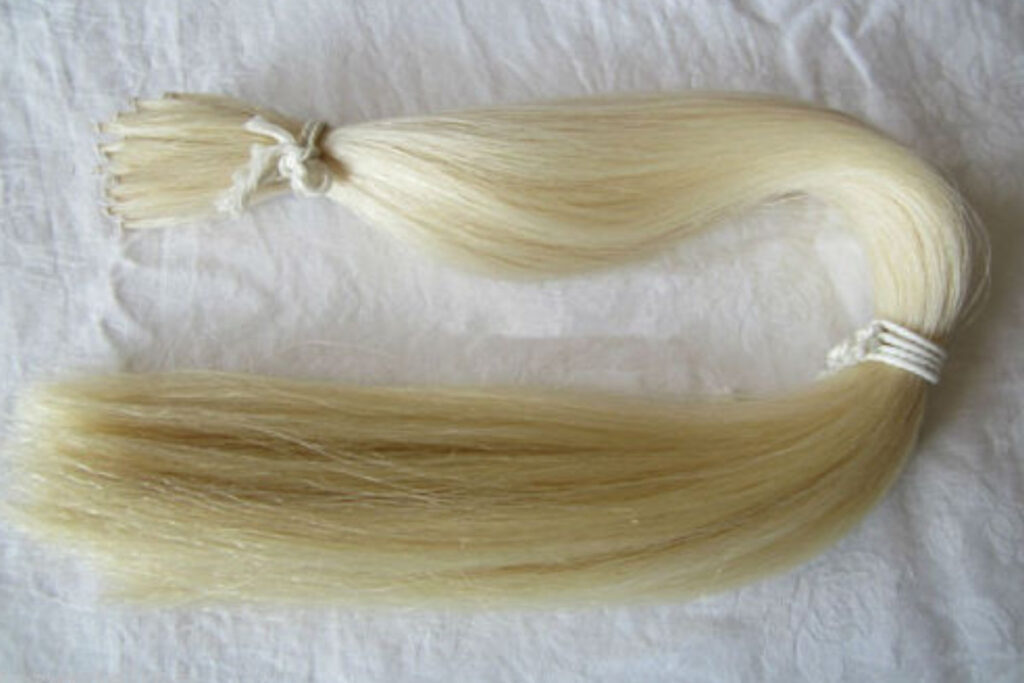What You Need To Know About Violin Bow Hair

The Violin Bow Hair
Violin bow hair is an indispensable element that greatly influences the sound of this beloved instrument. It forms an essential part of the violin bow and contributes to the production of the mesmerizing melodies we associate with the violin.
If you are a violinist or simply have an interest in stringed instruments, you must have witnessed how the violin bow interacts with the strings to create enchanting music.
The violin bow’s hair glides gracefully across the strings, allowing musicians to evoke the beautiful melodies we enjoy.
In this article, we will explore the world of violin bow hair. We will talk about its composition, the different types available, and its proper maintenance techniques.
So, join us as we uncover the secrets behind this vital component and discover the key role it plays in shaping the captivating music of the violin.
What is Violin Bow Hair?
The violin bow hair is a crucial and easily recognizable component of a violinist’s bow. It is the part of the bow that makes contact with the surface of the violin strings during play.
To create music, luthiers meticulously weave approximately 160 to 180 individual hairs into a ribbon-like strand.
This ribbon-like strand is stretched tightly between the bow tip and the frog. This is responsible for the interaction when drawing the bow across the violin’s strings to produce music.
This interaction creates friction, allowing the strings to vibrate and generate the instrument’s beautiful sound. The quality of sound is directly influenced by the interaction between the strings and the bow hair.
Therefore, the type of violin bow hair used and how it is strung play a significant role in achieving a pleasing sound.
This is why luthiers carefully select specific materials for the bow hair.
Their goal is to choose materials that are not only effective in producing the desired sound but also resistant to damage caused by the interaction between the strings and the bow.
Material Used for the Violin Bow Hair

Certainly, the material used for violin bow hair has a significant impact on its usability and performance.
For these purposes, we have two main classes of materials: natural and synthetic.
Each class of material has its own capabilities and characteristics that make it suitable for specific uses.
Historically, natural materials have been the preferred choice for both beginner and advanced violinists.
However, it is important to note that natural materials can be sensitive to factors such as humidity, breakage, and premature wear.
As a result, there has been a growing demand for alternative materials that can perform better under these conditions.
Thanks to advancements in musical instrument technology over the last two decades, we now have synthetic alternatives for violin bow hair.
These synthetic options have been introduced as excellent alternatives, offering comparable performance and durability to their natural counterparts.
They are designed to meet the needs of modern musicians and provide reliable alternatives.
In the following sections of this blog post, we will delve further into the discussion of both natural and synthetic materials used for violin bow hair.
Natural Violin Bow Hair

The natural material for violin bows hair is simply the hair from the tail of a horse.
For centuries, violin bow makers have favored horsehair as their primary choice due to its unique qualities. In fact, most of the professional violin bow hair is typically made from horsehair. These hairs are specifically from the tail of a horse.
It is typically off-white or light-colored and has a slightly rough texture. The length of the hair strands can vary but is generally around 30 to 32 inches (76 to 81 cm) long.
The horsehair is typically chosen for its unique properties, which make it suitable for bowing the strings.
This material possesses special qualities such as flexibility, and strength. It also has the ability to produce the desired sound when drawn across the violin strings.
Specifically, horsehair has a natural gripping ability attributed to the tiny scales on each strand, which play a crucial role in producing sound with the bow.
As the musician draws the bow across the strings, the tiny scales on the horsehair actively interact with the surface of the strings.
The interaction creates friction that enables the strings to vibrate and produce beautiful sounds.
Moreover, these scales enhance the grip of the hair, enabling musicians to have better control over dynamics and tone.
The Ideal Horsehair For Violin Bows
The ideal horsehair for violin bows is preferred by luthiers and often comes from horses living in cold climates.
These horses naturally produce thicker hair to keep warm. Siberian, Mongolian, Manchurian, Polish, and Argentinian horsehair are among the best options.
Stallion hair, in particular, is highly regarded for its cleanliness compared to hair from mares.
“Siberian stallion hair is widely regarded as the top choice.”
Please note that not all the hair harvested from the horsetail is used for bow-making.
After collection, the hair undergoes meticulous examination by workers who carefully sort each strand based on its color, length, and quality.
As a result of this rigorous inspection, the majority of hairs are deemed unsuitable and subsequently rejected.
Only a select few strands of good quality are chosen for use in bow-making.
The rejected strands, however, find alternative uses such as making fishing line, textiles, and other miscellaneous items.
Moreover, luthiers pay close attention to the quality of the hairs used in their bows. In fact, many even perform additional sorting themselves.
It’s worth noting that violin bow hair can also come in different colors.
We will focus our discussion on the colors of violin bow hair in the next section of this post.
The Colors of Violin Bow Hair
When discussing the types of natural horsehair colors used for violin bows, it often sparks conversations among traditionalists.
Bow hair comes in different shades, ranging from white to cream and eventually black. But the majority of bows used for violins are either white or cream.
Musicians often choose a specific color of horsehair based on the natural qualities associated with that color.
Generally, white bow hair is prevalent among violinists and can be seen on the majority of violin bows. It is widely used and easily recognizable.
However, in addition to white hair, there are other natural horsehair colors that musicians and luthiers may come across.
These variations can add a touch of uniqueness to the appearance of the bow. Some of these color variations include black and “black and white mix.”
White Horsehair for the Violin bow
White horsehair is the most commonly used color for bow hair. Its preference is due to the fine texture and other desirable qualities associated with it.
All white hair occurs naturally and comes from special breeds of horses, and it is important not to bleach it. Bleaching weakens the hair and increases its vulnerability to breakage when exposed to normal bow tension.
Using a horsehair that is naturally white and not bleached is crucial for white bow hair.
This is because bleached horsehair, similar to human hair, becomes more fragile and is not suitable for effectively playing the instrument.
There are also variations of bow hair that have a more tan or silver color. These variations generally behave similarly to white hair.
Lighter-colored hair, often referred to as Mongolian or Siberian hair, is preferred for higher-pitched instruments, making it a popular choice for violin bow hair.
Additionally, there are further variations of white hair, such as platinum white and golden white.
These variations have distinct characteristics and are used accordingly.
Platinum white hair offers more bounce and a pure tonality, while golden white hair is thicker and slightly more durable.
Black Horsehair for the Violin bow
This is a less commonly seen color for violin bow hair. Black horsehair has a coarser texture and exerts more aggressive tension on the strings compared to finer white hair.
Hence, it is preferred for playing the lower instruments like the bass and cello.
They believe that the rougher texture of black hair enhances their playing and adds a unique tonal quality to their instrument.
This is one of the reasons black horsehair is primarily used by bassists and some cellists in orchestras and less often by violinists.
However, a few violinists also choose black horsehair for their bows.
“White and Black Mix” Horsehair for Violin Bow
The blend of white and black horsehair, referred to as ‘salt and pepper,’ combines the characteristics of both colors to provide a balanced grip on the bow.
It offers enhanced control compared to pure white hair while avoiding the more forceful nature of pure black hair.
Moreover, musicians have another color option known as “cinnamon,” or brown hair. This color provides a similar medium consistency to white and black hair.
Choosing this color adds a distinctive visual element to the bow, offering musicians a unique aesthetic choice.
Observation about Horsehair Color
Typically, white and black horsehair are the primary colors used for violin bows and are common among violinists.
However, it’s important to note that the focus is primarily on the quality and performance of the hair rather than its color.
Luthiers and musicians prioritize finding horsehair that is strong, flexible, and capable of producing a clear and resonant sound.
Ultimately, the choice of horsehair color is a matter of personal preference and artistic expression.
Whether one prefers the traditional white or the less conventional black, what matters most is the quality and performance of the hair in creating beautiful music.
In addition to white and black hair, there are other types of horsehair that come in varying colors and originate from different regions where horses are raised.
However, obtaining these types of hair may require special ordering or working with what your local shop has in stock.
If you’re interested in trying something different or exploring a new sound, it’s a good idea to consult with your local shop.
They can recommend which type of bow hair would be best suited for your preferences and help you find the right option to enhance your playing experience.
Synthetic Violin Bow Hair
Traditionally, bow hair has primarily been made from horsehair. However, advancements in technology have led to the development of synthetic fibers that closely resemble horsehair.
Musicians have increasingly embraced these synthetic alternatives as substitutes for natural horsehair.
Synthetic bow hair offers a wide range of colors and length options to choose from.
However, it is important to note that they may not appeal to everyone and are often considered of lower quality compared to horsetail hair.
However, it has been claimed that with numerous technological advancements, synthetic bow hair has significantly surpassed horse hair in terms of quality.
Despite this, synthetic bow hair has its advantages. It is more durable than natural hair, resistant to wear and damage caused by changes in humidity, and has the potential to last longer than traditional horsehair bows.
Some musicians are particularly drawn to the stability and consistency provided by synthetic bow hair, making it an appealing choice for those seeking a reliable instrument.
Furthermore, out of ethical considerations, certain violinists opt for the use of synthetic vegan bow hair.
Why Do We Apply Rosin to Violin Bow Hair?
Applying rosin to the violin bow hair is important for getting a good sound. When the bow hair touches the violin strings, it needs to create friction.
Rosin, a sticky substance made from tree sap, is used to make the bow hair grip the strings better. This helps the bow vibrate properly and produce a rich tone.
Without rosin, the bow hair might slide too easily on the strings. This can make it harder to control the sound and make it weaker.
So, using rosin on the bow hair is necessary to achieve the best sound quality and performance when playing the violin.
Violin Bow Rehair

Note that there is no definitive answer as to how long a violin bow will last before it requires rehairing.
The lifespan of a bow is influenced by different factors. This include playing style, the climate you are in, and varying opinions from different sources.
However, with regular use over time, the hair on a violin bow can wear out and become less effective.
If you observe a significant number of broken hairs on the playing side of the bow, it is recommended to have it rehaired.
Failure to do so may result in warping as the excessive pressure on one side pulls the bow out of shape. This can potentially cause permanent damage to the bow.
Moreover, this can result in diminished sound quality, reduced control, and difficulties in producing the desired tone.
Click on the link here: “Everything You Need to Know About Violin Bow Rehairing“ to read and learn more about rehairing violin bows.
When the hair starts to lose its elasticity, become frayed, or break frequently, it is a sign that rehairing is needed.
During the rehairing process, the old hair is carefully removed from the bow and replaced with fresh horsehair.
Skilled bow makers or luthiers perform this task with precision, ensuring that the hair is securely attached to the bow’s frog and head.
Final Note
Violin bow hair plays a vital role in bringing the violin to life. When the bow hair comes into contact with the strings, it actively contributes to creating the enchanting sound we all adore.
It acts like a secret ingredient, infusing the music with a unique flavor.
Typically, bow hair for violins is crafted from horsehair or synthetic material. Some experts assert that Siberian stallion hair is the optimal choice for bow hair.
To ensure optimal performance, it is essential to take good care of the bow hair.
Treat it with care, keeping it in excellent condition. By doing so, you can enjoy creating beautiful music with your violin.
And remember, when the time comes, rehairing your bow is a necessary step to maintain its peak performance.
At Phamox Music, we go all out for exactness and honesty. For this purpose, if by any means you found any possible glitch, be it factual, editorial, or something that we need to update, kindly contact us.
If you find the information provided in this post “Violin Bow Hair” interesting and helpful, kindly share it with someone you know that might need it.







